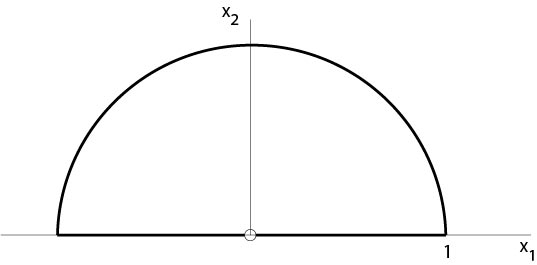7.3.1: Boundary Value Problems: Dirichlet Problem
( \newcommand{\kernel}{\mathrm{null}\,}\)
The Dirichlet problem (first boundary value problem) is to find a solution u∈C2(Ω)∩C(¯Ω) of
△u=0 in Ωu=Φ on ∂Ω,
where Φ is given and continuous on ∂Ω.
Proposition 7.4. Assume Ω is bounded, then a solution to the Dirichlet problem is uniquely determined.
Proof. Maximum principle.
Remark. The previous result fails if we take away in the boundary condition (7.3.1.2) one point from the the boundary as the following example shows. Let Ω⊂R2 be the domain
$$
\Omega=\{x\in B_1(0):\ x_2>0\},
\]

Figure 7.3.1.1: Counterexample
Assume u∈C2(Ω)∩C(¯Ω∖{0}) is a solution of
△u=0 in Ωu=0 on ∂Ω∖{0}.
This problem has solutions u≡0 and u=Im(z+z−1), where z=x1+ix2. Concerning another example see an exercise.
In contrast to this behavior of the Laplace equation, one has uniqueness if $\triangle u=0$ is replaced by the minimal surface equation
$$
\frac{\partial}{\partial x_1}\left(\frac{u_{x_1}}{\sqrt{1+|\nabla u|^2}}\right)+
\frac{\partial}{\partial x_2}\left(\frac{u_{x_2}}{\sqrt{1+|\nabla u|^2}}\right)=0.
\]
Contributors and Attributions
Integrated by Justin Marshall.


